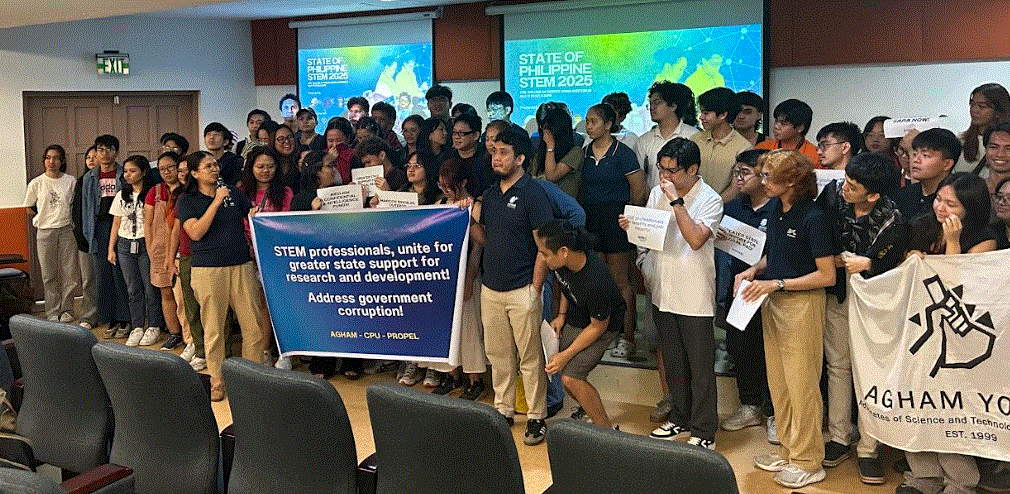PH scientists lament lack of gov't support for science and technology

A group of Filipino scientists said government support for science and technology remained wanting, and sought a comprehensive plan to strengthen the scientific community and its workers.
According to its data presented in a forum on Thursday, the Advocates of Science and Technology for the People (Agham) said the country's science and technology sector is critically underfunded and underperforming, falling far behind ASEAN and global standards.
Bea Panlaqui, officer-in-charge of Agham and a research associate at UP Diliman’s National Institute of Molecular Biology and Biotechnology, said scientists are getting "frustrated."
The group said the numbers point to a worsening trend in the funding, productivity, and workforce conditions of science and technology.
Budget
One of the starkest data points concerns public spending on research and development (R&D). While UNESCO recommends that developing countries allocate at least 1% of GDP to R&D, the group said the Philippines spent only 0.32% of its GDP on R&D in 2018 (the latest available public data).
In comparison, it said Singapore spent 2.2% of GDP, while Thailand spent 1.3% and Malaysia, 1.0%. The global average in 2018 was 2.23%, rising to 2.67% in 2022.
“Even if we’re seeing a slight upward trend, we are still three times lower than the minimum UNESCO recommendation,” Panlaqui said.
From a budget perspective, the Philippine R&D budget is decreasing year on year: P20.3 billion (2022); P19 billion (2023); and P18.2 billion (2024).
Agham also revealed that the Department of Science and Technology (DOST) originally proposed a P48.15 billion budget for 2025, but the approved funding was more than 50% lower, despite the Philippines being identified in the 2024 World Risk Report as the most disaster-prone country out of 123 nations.
In 2023, 2024, and 2025, the DOST's budget was P24.76 billion, P25.64 billion, and P28.46 billion, respectively.
Research output
Data on research productivity also shows a significant gap between the Philippines and its neighbors.
In 2022, Filipino researchers produced only 6,870 research papers, well below the ASEAN average of 16,568.
This places the country far behind Thailand, Malaysia, Indonesia, and Vietnam in scientific publication output.
Patent activity of research works also remains low. Only 674 patents were filed in the Philippines in 2022.
“Our Global Innovation Index ranking is misleading,” Panlaqui said. "It’s mostly based on high-tech exports like semiconductors, not original Filipino technologies. And we’re heavily dependent on high-tech imports instead of producing our own.”
STEM education, brain drain
In education, the Philippines ranked 75th out of 81 countries in mathematics and 78th in science in the 2022 Programme for International Student Assessment.
Less than 25% of Filipino students reached basic proficiency in core subjects, the study said.
Students in the Philippines were estimated to be five to six years behind their global peers in terms of learning levels.
Brain drain also persists despite the Balik-Scientist program, Agham said.
Though the Philippines ranked 37th out of 133 countries in the number of science, engineering, construction, and manufacturing graduates, it ranked only 86th in researchers per million population — with no growth since 2022.
According to Agham, from 1990 to 2010, there was a 182.5% increase in the number of overseas Filipino S&T professionals.
From 1990 to 2015, 3.7 million Filipinos earned science-related bachelor’s degrees, but only 19.6% worked in S&T jobs. A total of 80.4% ended up in unrelated fields or migrated abroad.
The Agham officer also said that STEM workers face a lack of security in the workplace.
Citing the Dynaslope Project, a landslide monitoring program under DOST-PHIVOLCS, as an example, she said that it suffered a 44% budget cut (from P45 million to P25 million), resulting in a one-third reduction in personnel and scaled-back operations in vulnerable communities.
IT professionals
In the same forum, preliminary results of a survey conducted by the Computer Professionals' Union (CPU) showed that a growing number of Filipino IT professionals are grappling with low wages, job insecurity, and a widening digital divide.
This was despite the country's acceleration in adopting digital technologies and artificial intelligence.
“We have an ongoing survey na nagko-collect ng mga answers for the past few months to ask IT professionals directly, ano nga ba ang mga hinaharap nilang mga problema namin," said Ian Aragoza, CPU education committee head.
(We have an ongoing survey collecting responses to ask IT professionals directly about the issues they face)
According to the CPU survey, the breakdown of IT professionals in the Philippines is as follows: freelancers (15.2%); public sector workers (28.3%); private sector employees (56.5%).
While the tech industry is often perceived as lucrative, Aragoza said the numbers reveal a stark reality for many workers.
“At least for the National Capital Region, P1,220 daily living wage. Gamit ang metric na ‘yun, nakita namin na around a third of IT professionals are living below this family living wage threshold," he said.
(For the NCR, the daily family living wage is P1,220. Based on this metric, we found that around one-third of IT professionals live below this threshold.)
The CPU survey found that 34.8% of respondents earn below the family living wage and 62.5% are at or above that threshold.
In terms of self-assessment on whether salaries meet their needs, 38.6% said their salaries do not meet daily needs; 22.7% said their income just meets their needs; and 38.6% said they earn more than enough.
The top concerns raised by IT professionals include unpaid overtime, heavy workload, lack of career progression, use of personal funds for work, inadequate leave benefits, and job insecurity.
“Ang mga IT professionals... humaharap din sa mga mabababang sahod na hindi naaabot ang kanilang daily needs at humaharap sa napakaraming issues sa kanilang trabaho.”
(IT professionals face low wages that don’t meet their daily needs and numerous workplace issues.)
Policy decision
Agham lamented that science advice continues to be ignored in key decisions, such as flood control and the Manila Bay reclamation.
“It’s clear from both numbers and case studies that science is not a policy priority under this administration,” said Panlaqui.
“Budgets are slashed, advice is dismissed, and workers are overworked and underpaid," she added.
AGHAM urged the government to realign its budget priorities, improve labor conditions for researchers, and invest more in science education and homegrown innovation.
“Without real investment, the administration’s promises remain words — and the country will keep losing its brightest minds,” Panlaqui said.
GMA News Online is seeking a reaction from the DOST, Department of Information and Communications Technology, and Malacañang on these matters. —LDF/VBL, GMA Integrated News




